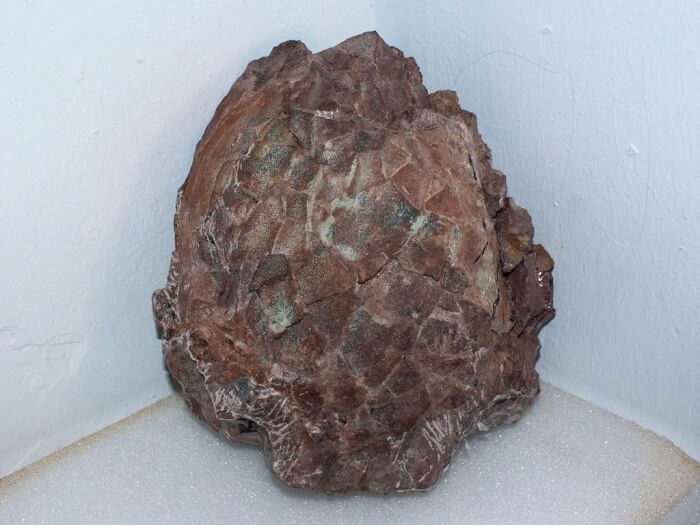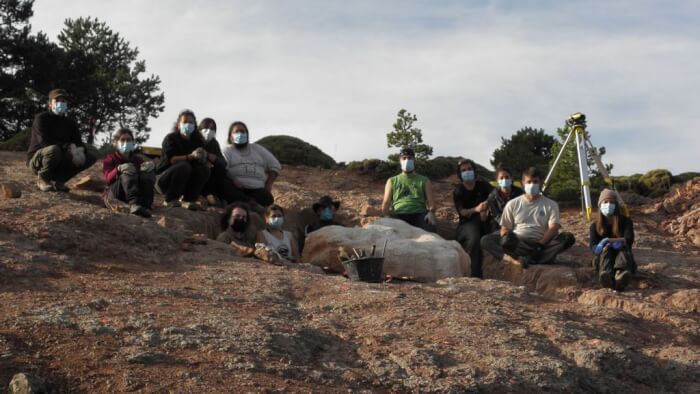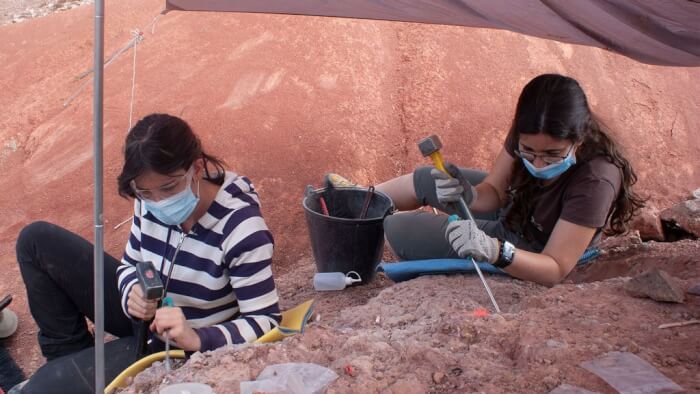Several Massive Dino Eggs Uncovered Within Fossilized Nest In Spain
30 titanosaurs eggs have recently been discovered lying beneath a 2-ton rock chunk in northern Spain. Experts assume that there could be up to 70 more eggs lying further below.
The eggs belonged to the titanosaur, a long-necked sauropod existed before the Cretaceous–Paleogene extinction event, according to preliminary examination. Specifically, the titanosaur is a quadruped herbivore having a long tail and neck extending more than 20 m (66 ft.) in length.
They were discovered at an excavation site in the city of Loarre in the north-eastern Spanish province of Huesca when paleontologists from the Aragosaurus-IUCA Group of the University of Saragossa in collaboration with Nova University Lisbon were conducting their operation in September.
Dr Moreno-Azanza, a Spanish archaeologist from Nova University Lisbon, revealed that they dug up 2 nests in 2020, holding 30 eggs beneath the rock. He continued that his team believes that 70 additional eggs may lie deeper underneath the rock, leading to the total being around 100 eggs.
He said that using a bulldozer, together with the effort of 5 people working 8 h a day for roughly 50 days, they were finally able to dug up the nest. “It is unusual for blocks of this size to be extracted in a paleontological operation, but despite the technical difficulties involved in this process, the operation was considered a success,” stated Dr Moreno-Azanza.
Scientists hope that the space will be open the next spring, allowing visitors to inspect the work of preparing and researching the remains of this site in person. There would be 2 display rooms in the museum, highlighting the site’s significance and clarifying the methodology of such a complicated paleontological dig.
The city council of Loarre donated the space, already an exceptional construction, thanks to the artistic work synchronized between Teresa Sempere from El Artelier (art workshop) who drawn a huge mural on the façade of the construction hosting the display.
Funding for the next 36 months has also been raised for the Loarre Dinosaur Eggs project, primarily from the Portuguese Foundation for Science and Technology and the Spanish Ministry of Science.
The eggs belonged to the titanosaur, a long-necked sauropod existed before the Cretaceous–Paleogene extinction event, according to preliminary examination. Specifically, the titanosaur is a quadruped herbivore having a long tail and neck extending more than 20 m (66 ft.) in length.
They were discovered at an excavation site in the city of Loarre in the north-eastern Spanish province of Huesca when paleontologists from the Aragosaurus-IUCA Group of the University of Saragossa in collaboration with Nova University Lisbon were conducting their operation in September.
 Source: Zenger
Source: Zenger
The first extracted titanosaur egg near Huesca in northern Spain.
The project is being directed by Dr Miguel Moreno-Azanza, Carmen Nunez-Lahuerta, and Eduardo Puertolas with the involvement of 25 palaeontologists and students from Spanish, Portuguese and German institutions.Dr Moreno-Azanza, a Spanish archaeologist from Nova University Lisbon, revealed that they dug up 2 nests in 2020, holding 30 eggs beneath the rock. He continued that his team believes that 70 additional eggs may lie deeper underneath the rock, leading to the total being around 100 eggs.
 Source: Zenger
Source: Zenger
Carmen Nunez Lahuerta, a director of the excavation, works on a block containing a dinosaur nest near Huesca in northern Spain.
The eggs are spherical, exceptionally preserved, with a diameter of about 15 cm (5.9 in). “The main objective of the 2021 campaign was the extraction of a large nest that contains at least 12 eggs that were integrated into a block of rock weighing over two tons,” said Dr Moreno-Azanza.He said that using a bulldozer, together with the effort of 5 people working 8 h a day for roughly 50 days, they were finally able to dug up the nest. “It is unusual for blocks of this size to be extracted in a paleontological operation, but despite the technical difficulties involved in this process, the operation was considered a success,” stated Dr Moreno-Azanza.
 Source: Zenger
Source: Zenger
The excavation team poses at the site where the titanosaur eggs were found near Huesca in northern Spain.
The big block, together with 10 other tinier eggs drawn out this year have been moved to a short-term storage in the municipality of Loarre, awaiting the fulfillment of tasks related to the future Laboratory-Museum.Scientists hope that the space will be open the next spring, allowing visitors to inspect the work of preparing and researching the remains of this site in person. There would be 2 display rooms in the museum, highlighting the site’s significance and clarifying the methodology of such a complicated paleontological dig.
 Source: Zenger
Source: Zenger
Ester Diaz Berenguer and Raquel Moya Costa from the University of Zaragoza worked with the dinosaur eggs discovered near Huesca in northern Spain.
Dr Moreno-Azanza also said: “The exhibition, which will function as a satellite room of the Museum of Natural Sciences of the University of Zaragoza, will feature both real specimens from the Loarre site and replicas of dinosaur eggs from other parts of the world.”The city council of Loarre donated the space, already an exceptional construction, thanks to the artistic work synchronized between Teresa Sempere from El Artelier (art workshop) who drawn a huge mural on the façade of the construction hosting the display.
Funding for the next 36 months has also been raised for the Loarre Dinosaur Eggs project, primarily from the Portuguese Foundation for Science and Technology and the Spanish Ministry of Science.
Share this article
Advertisement